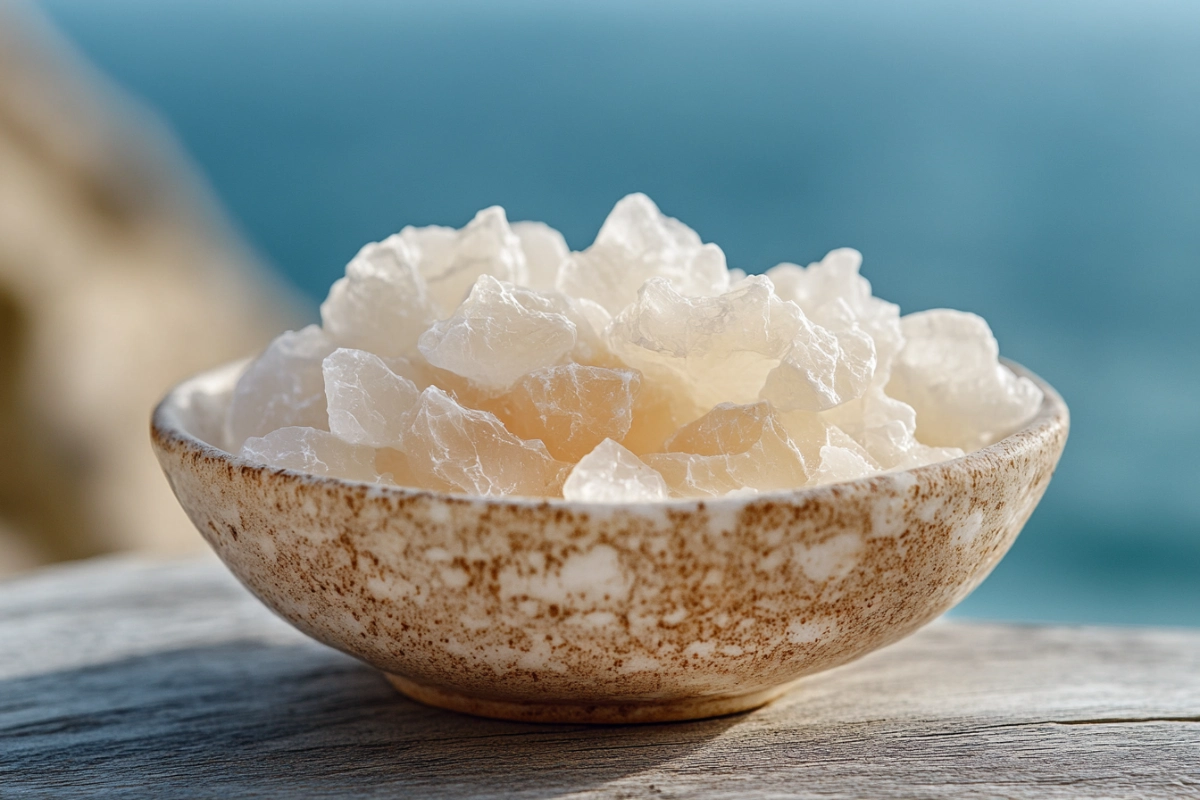Fleur de Sel is not your average table salt—it’s a culinary gem, cherished by chefs and food enthusiasts worldwide. Hand-harvested from the pristine salt marshes of France, this gourmet salt boasts a delicate texture, nuanced flavor, and natural beauty that elevate any dish to new heights. From its meticulous harvesting process to its luxurious flavor profile, this gourmet salt embodies the essence of fine dining. This article will unravel what makes Fleur de Sel so special, explore its unique attributes, and provide practical tips for incorporating it into your culinary adventures.
Introduction to Fleur de Sel
What is Fleur de Sel?
The name Fleur de Sel translates to “flower of salt,” a poetic nod to the delicate salt crystals that bloom on the surface of salt ponds. This French sea salt is meticulously hand-skimmed from shallow pools along the Atlantic coast, particularly in regions like Guérande, Brittany, and Camargue. Unlike conventional salts that are machine-processed, this gourmet salt is a product of both nature and tradition, with its collection dating back centuries.
But what sets this salt apart? Fleur de Sel is renowned for its moist texture, mineral-rich taste, and distinctive flakey crystals. It’s often referred to as the “caviar of salts” due to its rarity and premium quality. Each crystal forms under specific weather conditions, requiring a perfect blend of sun, wind, and humidity.
Why is it Unique?
Not all salts are created equal, and Fleur de Sel proves it. What makes Fleur de Sel so special is its briny, oceanic flavor and slightly sweet undertones. Unlike regular sea salt, it contains trace minerals like magnesium and calcium that enhance its taste and health benefits. Moreover, its natural salt flakes dissolve slowly on the palate, delivering bursts of flavor and crunch.
This gourmet salt isn’t just about flavor—its texture is equally enchanting. The crystals are moist and stick together, making them ideal for garnishing dishes. This luxurious finishing touch transforms ordinary meals into gourmet experiences.
The Intricate Harvesting Process
How is Fleur de Sel Harvested?
Harvesting Fleur de Sel is a labor of love and skill, deeply rooted in tradition. Unlike mass-produced salts, this premium ingredient is meticulously hand-skimmed from shallow salt pans found along the French coastline, particularly in Brittany and Camargue. This process is highly seasonal and weather-dependent, requiring the perfect mix of sun, wind, and humidity to encourage the delicate salt crystals to form.
Harvesters, known as paludiers, use wooden rakes to gently skim the fragile “flower” of salt that floats on the water’s surface. This ensures that only the purest crystals are collected. The technique is so precise that it hasn’t changed much for centuries, preserving its artisanal charm.
Why the Process Affects the Price
It’s no surprise that this gourmet salt commands a premium price. The process yields only a small amount of salt per harvest, making it one of the rarest culinary salts. Additionally, its production is labor-intensive, relying on the expertise of skilled workers. This combination of rarity and craftsmanship explains what makes Fleur de Sel so special and why it is often dubbed the “champagne of salts.”
For a deeper dive into gourmet salt harvesting and other culinary treasures, check out Fleur de Sel: The Ultimate Guide to Gourmet Salt.
Taste and Texture of Fleur de Sel
Distinct Flavor Profile
This gourmet salt is celebrated for its nuanced, oceanic flavor that sets it apart from other salts. It’s briny yet subtly sweet, with mineral-rich undertones that enhance the natural taste of any dish. Unlike processed table salt, it retains trace minerals like magnesium and calcium, adding depth to its flavor profile. These characteristics make Fleur de Sel a favorite finishing salt for chefs and home cooks alike.
What is so special about this premium ingredient? Its flavor is not just salty but complex, lending an elegant touch to everything from seared steaks to chocolate chip cookies. This delicate balance of brininess and minerality elevates the simplest ingredients into gourmet creations.
Unique Texture
Texture plays a big role in Fleur de Sel’s appeal. Its moist, flaky crystals give it a pleasant crunch that melts delicately on the tongue. This texture not only enhances its flavor delivery but also provides a satisfying contrast in dishes like roasted vegetables or desserts.
Unlike dry, processed salts, Fleur de Sel’s moisture content helps it stick to food surfaces, ensuring every bite is perfectly seasoned. This is why it’s often used as a garnish, where its texture and taste can truly shine.
Culinary Uses and Pairings
Finishing Salt Applications
Fleur de Sel isn’t your average salt; it’s a finishing touch that transforms everyday dishes into culinary masterpieces. Its delicate crystals and mineral-rich flavor are best appreciated when sprinkled over food just before serving. Because cooking with it can diminish its unique texture and taste, it’s reserved for enhancing the final presentation of a dish.
From savory to sweet, Fleur de Sel shines across a variety of recipes. Use it to highlight the flavors of roasted vegetables, grilled fish, or a perfectly cooked steak. It also pairs beautifully with desserts—think salted caramel, brownies, or even fresh fruit like watermelon. Its crunchy texture adds an irresistible contrast to soft or creamy foods.
Curious about other creative ways to elevate your dishes? Explore this guide to gourmet salt and its uses.

Pairing Tips for Chefs
Pairing Fleur de Sel with bold or earthy flavors creates unforgettable combinations. Charred vegetables, aged cheeses, and rich chocolate desserts are perfect candidates. For a simple yet stunning appetizer, sprinkle it over warm bread with olive oil. The briny sweetness of french sea salt complements smoky or tangy dishes, like barbecue or citrus-glazed seafood.
Remember, a little goes a long way. A pinch can elevate a dish without overwhelming its natural flavors. What is so special about this premium ingredient? It’s the way it harmonizes with a dish, enhancing its best qualities without overpowering them.
Substitutes for Fleur de Sel
Alternative Finishing Salts
If Fleur de Sel isn’t available, don’t worry! Several finishing salts can replicate its gourmet appeal. Maldon sea salt, with its light flakes and clean taste, is a popular substitute. Himalayan pink salt is another option, offering a similar mineral complexity but with a firmer texture. Cornish salt, with its slightly larger crystals, can also stand in for this gourmet salt.
Each alternative has its own flavor profile and texture, so experimenting is key. While no salt perfectly replicates Fleur de Sel’s delicate crunch and unique brininess, these options can come close in both presentation and taste.

Pros and Cons of Substitutes
The biggest advantage of substitutes is their availability and affordability. They’re easier to find in grocery stores and often cost less than Fleur de Sel. However, their moisture content and texture may differ, which can affect how they interact with food. For example, Maldon salt is drier, and Himalayan salt lacks the oceanic flavor that makes Fleur de Sel so distinct.
Ultimately, the choice of substitute depends on the dish and the desired effect. While substitutes are useful in a pinch, they might not fully capture what is so special about this premium ingredient.
Storage and Longevity
How to Store Fleur de Sel
Proper storage is crucial to maintaining Fleur de Sel’s prized qualities. Its high moisture content is part of what makes it so special, but it also means it needs to be handled carefully. To keep your Fleur de Sel fresh and clump-free, store it in an airtight container made of glass, ceramic, or porcelain. Avoid plastic or cardboard packaging, as these materials can absorb moisture or transfer unwanted odors to the salt.
Place the container in a cool, dry spot away from direct sunlight or heat. Humidity can affect the texture of the salt, causing it to clump or lose its delicate flakiness. By following these steps, you’ll ensure your this premium ingredient stays fresh and flavorful for years.
Does it Expire?
Unlike other pantry staples, salt doesn’t spoil in the traditional sense. However, Fleur de Sel’s unique texture and flavor can diminish over time if it’s not stored properly. The moist crystals might dry out or absorb surrounding odors, which can alter its taste.
The good news? When stored correctly, Fleur de Sel can last indefinitely while retaining its special qualities. Regularly check its texture and aroma to ensure it’s in peak condition. After all, what is so special about this premium ingredient if not its freshness and unique characteristics?
FAQs About French sea salt
What Sets Fleur de Sel Apart from Table Salt?
This gourmet salt is known for its light, flaky crystals and mineral-rich taste. Unlike standard table salt, which undergoes heavy processing and is uniform in texture, Fleur de Sel retains its natural, irregular shape. Its slightly moist crystals offer a satisfying crunch and enhance the complexity of any dish.
Should I Cook with Fleur de Sel?
While it’s tempting to use this premium ingredient in every part of a recipe, it truly shines as a finishing touch. Heat can compromise its unique texture and subtle flavor, so it’s best sprinkled over dishes like roasted vegetables, seared meats, or even desserts to make the most of its qualities.
Why Does this premium ingredient Cost More?
Its high price reflects the effort involved in its creation. The delicate process of hand-harvesting and the limited amount produced each season contribute to its exclusivity. This labor-intensive method ensures that each batch maintains its exceptional quality.
Conclusion: Why Fleur de Sel Stands Out
This extraordinary salt represents the intersection of tradition and taste. Its distinctive crystals, oceanic flavor, and artisanal harvesting process set it apart as a premium ingredient that can elevate both simple and elaborate dishes.
What makes it truly special is its ability to enhance flavors without overpowering them. Whether used as a garnish for savory meals or to balance sweetness in desserts, this premium ingredient brings an unmistakable touch of elegance.
For chefs and home cooks alike, it’s proof that even small details can have a big impact. With thoughtful storage and mindful use, this exceptional salt can be a lasting addition to your kitchen.
Related Resources
If you’re inspired to explore more culinary possibilities with Fleur de Sel, there’s a wealth of resources to guide you. Whether you’re looking to enhance your cooking skills or simply want to learn more about gourmet ingredients, check out these related articles and guides:
- “How to Use Gourmet Salts in Everyday Cooking” for tips on elevating your meals.
- “The Secret to Perfectly Seasoned Desserts” for insights into balancing sweet and salty flavors.
- “A Beginner’s Guide to Finishing Salts” for a closer look at other luxurious options.
Curious about incorporating Fleur de Sel into recipes? For a creative twist, explore dishes like salted caramel brownies, chocolate-dipped fruit, or even gourmet popcorn. this gourmet salt isn’t just an ingredient—it’s an experience worth savoring.

